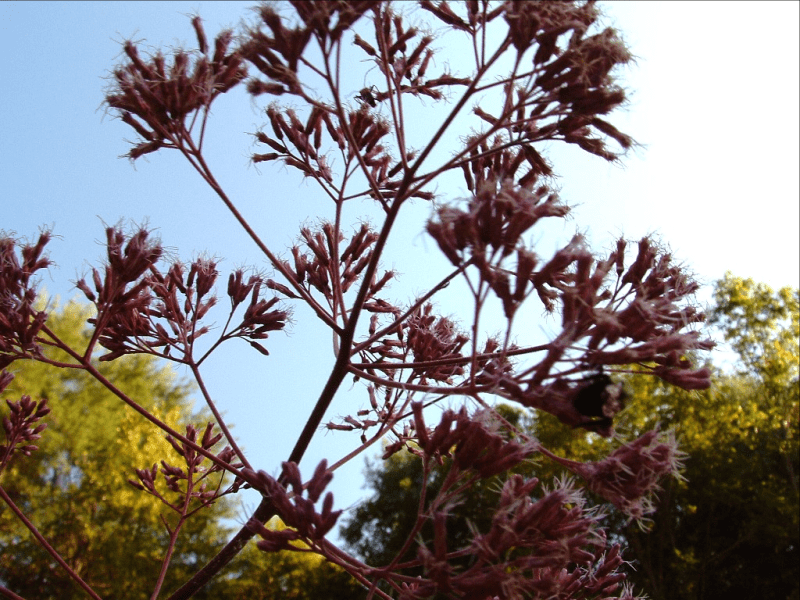
Eupatoriadelphus-fistulosus better known as Queen of the Meadow is in full bloom along the roadsides and banks where I live. It’s a towering wildflower-with light pinkish blooms.
The bees and bugs are having a hay day with the ones growing along the edge of our backyard. As I walk by on the way to the clothesline it seems I hear them buzzing to each other-“This is the last hurrah of summer-suck up all you can. Old Man Winter is soon coming.”
I’ve never understood the common name for the flower. Maybe it’s called Queen of the Meadow because it towers over most of the other plants (subjects).
When I look around and see so many of them-I think how could they all be Queens? To me they seem more like tall skinny old biddies. Each one bragging that they are the real Queen of the Meadow and they alone know the secret of impending winter. The irony of course being-they are each in a meadow full of Queens-and every growing thing which surrounds them is telling their secret of the last of summer and the coming death of winter.
Tipper
This post was originally published here on the Blind Pig in August of 2011.


I went and looked up Eutrochium Fistulosum out of pure curiosity to see if we have any of the stately light pink-to-lavenderish plants growing here in the sandhills and found they’d be a rare sight here cause they like cooler winters than we usually have. I also found out that there are many of this type of plant some call Queen of the Meadow, although this one’s other names are usually hollow Joe-Pye weed, trumpetweed, or purple thoroughwort.
The more beige-to-yellowish bloomed Filipendula Ulmaria also called meadowsweet or mead wort, is also referred to as Queen of the Meadow, Pride of the Meadow, Meadow-Wort, Meadow Queen, Lady of the Meadow, Dollof, Meadsweet, and Bridewort, that grows in damp meadows, native throughout most of Europe and Western Asia (Near east and Middle east) – although it has been introduced and naturalized in North America.
http://en.wikipedia.org/wiki/Eutrochium_fistulosum
http://en.wikipedia.org/wiki/Filipendula_ulmaria
Interesting! Sure wish some grew here, but God knows what He’s doing; if He designed for it to be here, I do believe it’d be here. LOL
God bless.
RB
<><
Tipper,
I’ve heard you all talking about
this wild flower, but I don’t recon I’ve seen these, ever. Maybe I just wasn’t paying attention, but I’m in the woods alot.
My neighbor, friend, brought me a
pint jar of his homeade Cherry Wine yesterday evening. I asked if I should sit down to taste it. He just grinned and said it’s good for arthritis sippin’…Ken
A clothesline – I love the smell of fresh outdoor drying of clothes. I miss that smell. The ‘Queens’ are around here, too, in Caldwell County. They do tower over all, but it shows that they know they are present.
We didn’t have those any more here in Burke County. The stink bugs killed them all. Well maybe not killed them. They just bugged then to death.
“Queen of the Meadow,” in addition to its Latin botanical name which Tipper has so efficiently given us, also has other common names: “Lady of the Meadow,” Gravel Root, Trumpet Weed, Purple Boneset, Pride of the Meadow, Meadowsweet, Bridewort and others. Some also call it Joe Pye Weed, although the two have differing characteristics. It seems the prolific plant has about as many names as the localities in which it grows and the herbal uses made of both the flowers, the stems and the roots. Its herbal history gives various uses of the tannin and salicylic acid (among other healing virtues) found in this plant. People used to use both its crushed blossoms and leaves as an air freshener, even scattering it on their floors to be walked upon to crush out the aroma. Its uses in herbal medicines could fill pages. It is good for the central nervous system as well as the kidneys, liver, arthritis, migraine headaches, cystitis, thyroid and more. One practicing herbalist recommends making a tea of Queen of the Meadow leaves, but warns “It is a very strong herb. Drink no more than one cup of tea a day, and that in increments of a spoonful at the time. Do not use it as a regular drink, but use only for one week. Then skip three or four weeks before treating with Queen of the Meadow tea again.” My grandmother (Sarah Evaline Souther Dyer) who lived from 1857-1959 was a noted herbalist in her community. I’m sure if I had access to her medicinal “receipts” (as she called them), I would know better what use she made of Queen of the Meadow and what ailments she treated with the herb.
They are very beautiful…do they don’t remember ever seeing them where I used to live..In Va.
This peaked my curiosity so I first googled “Queen of the Meadow” and found it’s also called Meadowsweet. But the scientific name is Filipendula ulmaria.
When I googled eupatoriadelphus fistulosus I ended up with Hollow Joe Pye Weed. The pics look the same.
It certainly is that time of year. I can feel it in the air and I can smell it in the air. I see the early signs and feel it in my bones.
Hey Good Morning Tipper,
I have always called this plant Joe Pye Weed, AKA Jopi, AKA Queen of the Meadow…Ours here on our place is almost purple. I think it is because of the dryer spot it is in!
I love it, beautiful and a contrast to all the yellow that is blooming now!
Have a good day!
Thanks Tipper,